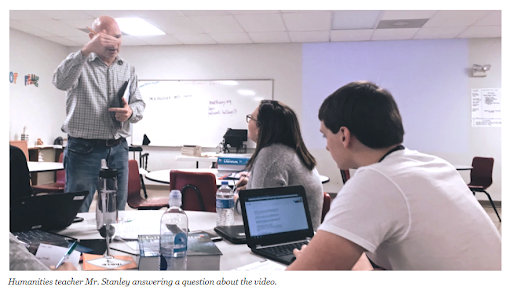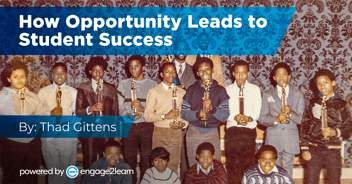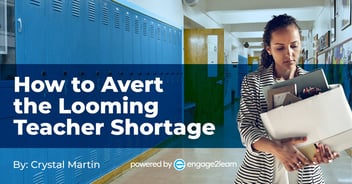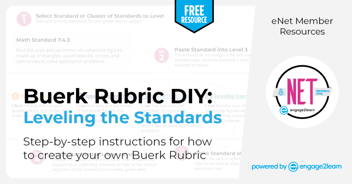Series: How can schools keep learners more engaged? | engage2learn
Welcome to the engage2learn Leading Learners blog series! We asked students across the state of Texas to write blogs about improving education. For their first assignment, they tackled the topic, “How can schools keep learners more engaged?”
Hear what Kilgore ISD student Anushka has to say about her experience in school, and how it can be improved.
“Humans are curious by nature.” (Aristotle)

An engaged class is the key to better grades, but everything comes down to the school and the learning environment. Without the school’s effort to pursue engagement in the class, the motivation diminishes due to students believing they aren’t “cared about.” The encouragement to strive and discover new interests start from the school administrators and students.
Communication
When teachers are introduced to new students, getting to know each student personally can help them open up more and explain their strengths and weaknesses in the subject. Knowing these strengths and weaknesses can help adjust a teacher’s style in certain areas for the understanding and success of the student.

Humanities teacher Mr. Stanley answering a question about the video.
Allowing the students to choose the pace of each lesson can help adjust to each individual’s style of learning. After completing the unit, students can provide feedback on what they learned and how the lesson can be improved. Sending surveys is one of the many ways to obtain this information.
Teachers are often bugged with the question on what they are doing that day. A lesson outline with the corresponding TEKS can answer this frequent question. Many school districts distribute calendars to inform the community of events that go on throughout the year. If teachers did the same, both the student and teacher will be prepared and organized to take on the new year.
Behavior
It may not be the teacher or school’s fault students are distracted in class. Sometimes their peers are the problem. Their behavior in class can reflect who’s guilty. A main distraction in the classroom is student cell phones. Every notification is another dose of oxytocin released in these highly addictive pieces of tech.
According to a survey conducted by SAM Labs, 48 percent of the teachers surveyed believe students retain more information with technology. Click To Tweet
According to a survey conducted by SAM Labs, 48 percent of the teachers surveyed believe students retain more information with technology. But some students abuse this privilege and enter inappropriate sites without the professor’s consent. Website filters are often added, yet this cannot be relied upon if the filters are not specific enough to block malicious websites. The best solution is to enforce technology security and the strict use of personal devices to provide a more desirable learning environment.
Application of Knowledge
Remembering facts from past classes can signal that the individual was taught in a way that benefited them. The subject will be easier to teach and add onto the prior knowledge a learner has already acquired. Not all students react the same way to every teacher’s style. A few students may still be struggling with the previous unit, either because they didn’t understand the lesson, or it was a weakness that was not worked on in the past.
Before teachers receive state assessment scores, they are run by school administrators. Whenever school administrators notice a section of students struggling in an area, a meeting with the teachers should be made, so no child is left struggling with the same problem. If this happens, the recalling of previous facts will be simpler and help with integrating new information into the student’s memory.
According to the results of Shernoff’s 2001 study, he discovered that students who experienced more engagement in high school science classes were more likely to major in college sciences a couple years later. In other words, a student will be committed to succeeding in the future if they are engaged in class. A school leader may not be able to find every specific style of learning for each student, but the goal must be followed through for future generations to come.
Six Approaches to Promote Learner Engagement
In the realm of education, extensive research has illuminated the undeniable impact of learner engagement on a student's academic success. It has become increasingly evident that a vibrant and positive learning environment permeating the entire school is paramount.
Drawing on the expertise of educators and researchers, six powerful approaches have been identified to not only promote learner engagement but also cultivate a schoolwide culture that nurtures active learning. These approaches serve as a compass, guiding educators towards creating an educational ecosystem that sparks curiosity, fosters collaboration, and ignites a genuine passion for lifelong learning.
- Promote Active Learning Methodologies. Promoting active learning methodologies enhances student engagement by incorporating interactive and collaborative learning activities, such as group debates, hands-on experiments, and problem-solving tasks. These approaches encourage students to actively participate in the learning process, stimulating critical thinking, knowledge application, and creativity.
- Differentiate Instruction. Differentiating instruction ensures that all students are challenged and engaged by employing strategies such as tiered assignments, flexible grouping, and a diverse range of assessment formats. By tailoring teaching methods, content, and assessments to individual students' strengths, readiness, and interests, educators can effectively address students' diverse learning needs.
- Incorporate Real-World Relevance into Content. Students need to see how classroom content could be applied in the real world for it to be meaningful and engaging to them. Guest speakers, field trips, and project-based learning experiences allow students to connect what they are learning to their world. That connection fosters a deeper understanding and retention of content knowledge.
- Integrate Technology into the Curriculum. When teachers integrate technology into curriculum, learning is enhanced through the incorporation of digital apps, virtual simulations, interactive multimedia, and online platforms. These tools provide personalized, immersive learning experiences and offer immediate feedback to students, enriching their educational journey.
- Provide Timely and Constructive Feedback. Students need feedback from the teachers and school to understand their progress, identify what needs improvement, and feel supported on their education journey.
- Create a Positive School Learning Environment. Encouraging student participation, creating opportunities for student choice and open communication, and fostering a culture of respect and celebration of diverse perspectives is essential for a positive and inclusive school learning environment.
TEA and Engage2Learn Partnership for Coaching & Supporting Educators
Proven research findings led state school agencies, such as the Texas Education Agency (TEA), to engage in strategic education planning to develop strong school leadership and teacher program initiatives that employ effective strategies to keep learners actively engaged and create a positive school learning environment to improve student achievement.
engage2learn is a Texas Education Agency (TEA) approved, vetted school improvement program partner. e2L’s Catalyst Coaching Program was developed to prepare and support school leaders, principal supervisors, and teachers to implement high-quality instruction in every classroom and transform school culture. The Catalyst Coaching Program incorporates coaching educational leadership, consists of 4 components as follows:
1. Principal Supervisor Training & Coaching
Principal Supervisors undergo specialized training that equips them with critical strategies for effectively supporting school leaders. This training is tailored to address the specific Prioritized Focus Areas outlined in the school's Targeted Improvement Plan (TIP).
2. Leadership Training & Coaching for School Leaders
School leaders receive invaluable school leadership coaching and implementation support to guide them in designing systems that drive transformative school culture. The aim is to cultivate a nurturing environment conducive to the development and retention of high-quality teachers capable of delivering exceptional instruction in every classroom.
3. Teacher Training & Coaching
e2L's team of certified coaches provides teachers with targeted, intensive support through personalized coaching, facilitated through the innovative platform of GroweLab. This unique approach allows teachers to receive guidance and coaching remotely, leveraging the power of technology to enhance their instructional practices. The coaching provided focuses on effective instructional strategies that have been proven to enhance both objective-driven daily lesson plans and data-driven instruction. With GroweLab, our organization is committed to delivering comprehensive and accessible coaching experiences for teachers, ensuring continuous growth and development in their instructional abilities.
4. Talent Development Platform for Educators
All participants of the program receive access to GroweLab, which is a tailored all-in-one instructional coaching platform for educators to demonstrate growth through evidence-based coaching on leadership and instructional best practices. GroweLab also includes a vast library of learning resources and an intelligent, self-guided coaching system that ensures users can learn and grow at their convenience.
Curious to learn more about The Catalyst Coaching Program and the transformative power of GroweLab? Reach out to us today at engage2learn.org and discover how this dynamic program can improve school culture.



